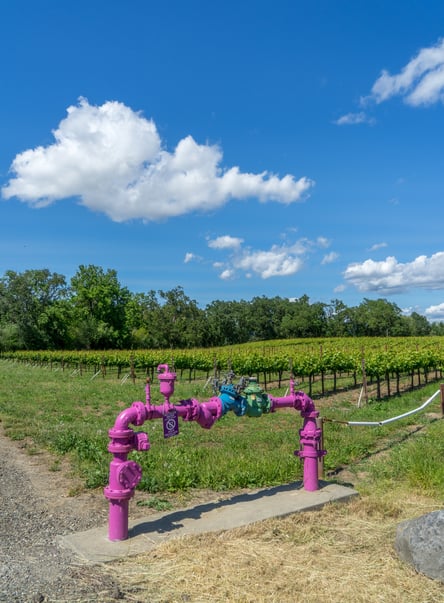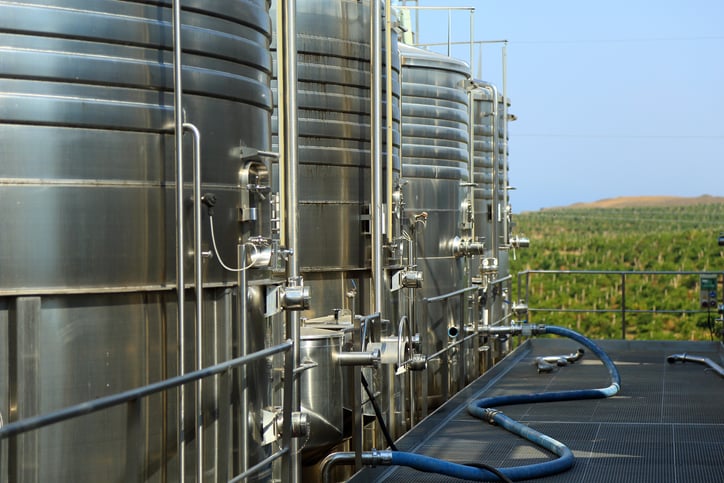With all signs pointing to more frequent drought and more severe water restrictions, vineyards are looking to tools and techniques that can help them adapt in the long term. Among them: increased use of recycled water.
“Increasing the available water from treatment plants, reducing the amount of domestic water used in facilities, and exploring efficient and cost-effective solutions to clean and recycle wastewater will be increasingly important for agricultural production in the years ahead,” says Miguel Garcia, Sustainable Agriculture Program Manager for the Napa Resource Conservation District.
First: is recycled water safe for vines?
Even before considering costs or logistics, most growers have the same initial question about using recycled water in their vineyard: will it affect grape quality? The research indicates not—at least if it's managed correctly.
One recent study compared conventional irrigation with well water to irrigation with recovered wastewater at two large-scale wineries in Northern California, each with different soil characteristics and varietals. At both sites, researchers found very little difference in the chemical composition of the soil, vines, or grapes as a result of using recycled water—and sensory analyses of wines produced at each site revealed no differences, either.
In another project, Maya Beulow, a researcher with the UC Davis Department of Land, Air and Water Resources, collected and compared nearly two years' worth of monthly samples of untreated and treated wastewater in Sonoma County and the cities of Ukiah, Napa, Lodi, King City, and Paso Robles. She and her co-authors also concluded that the wastewater was nontoxic for the vines.

One potential area of concern is the sodium content of recycled water, which can be elevated as a result of the chemicals used in the treatment process. Over time, and depending on the nature of the soil where the recycled water is applied, the accumulation of sodium and potassium in soil can cause crusting and ponding.
However, Beulow says that testing wastewater and soil composition can help growers anticipate and mitigate how the two will interact—for example, with gypsum amendments or by switching to potassium-based wastewater cleaners. “You just need to have all the parts of the puzzle,” Beulow told Wines Vines Analytics. “We really are convinced it’s possible to safely use your wastewater.”
Reusing water from vineyard operations
Some vineyards—including the Napa RCD's educational vineyard in Carneros—can access recycled water from treatment facilities, sometimes mixing it with rainwater or their own well water. Other vineyards recycle excess water from day-to-day operations on site—such as cleaning and sanitation or grape processing.

Producing a gallon of wine results in roughly seven gallons of wastewater. Growers can pump that water, which contains grape residues and sugars, into a reservoir where solids sink to the bottom.
"The problem with this passive cleaning of water is that any solids remaining in the water can clog irrigation lines," says Garcia of the Napa RCD. For this reason, he recommends the use of biofilters.
“Think of a biofilter as a miniature ecosystem," Garcia says. "These natural filters, made of vegetation, root systems, rocks, and sand, naturally clean the water to remove the excess solids and nutrients so it can easily pass through irrigation lines without clogging them.”
As with those using recycled water from treatment plants, vineyards reusing their own wastewater must also be mindful of its interaction with the soil. Cleaning products may lead to sodium buildup, while grape solids and juices can elevate potassium levels. Unmanaged, either can disturb soil structure or become toxic to vines.
Recycling in action: Trinchero Family Estates
Though implementing use of recycled water takes care and attention, many growers are finding creative ways to make it work. Longtime Ceres Imaging partner Trinchero Family Estates, among the largest wineries in the country, is one example. The operation treats winery wastewater for cleaning equipment, landscaping, and to grow crops. It's also exploring ways to use treated wastewater in cooling towers.
Ted Wells, environmental compliance and engineering manager, notes that recycled water applied to the land must meet specific requirements to protect groundwater and grape quality. But even when recycled water can't be used in the vineyards themselves, Trinchero has another solution: they partner with a local rancher who grows corn, sorghum, and rye for cattle feed.
These crops can take advantage of the nutrients in the treated wastewater, including the water available during the summer and after harvest. "Wastewater components vary according to what processes are taking place," Wells explains. "The vines require very precise, consistent inputs, but these other crops and the landscaping readily accept the variability in nutrients."
Critically, recycling is just one aspect of the business's holistic approach to water conservation. “We focus on minimizing and optimizing water use,” says Wells. For example, winemakers plan to receive grapes on a schedule designed to minimize cleaning between varieties. Automation, pressure washing, and air cleaning also play a role.
"Monitoring and tracking each part of the process enables us to know exactly how much water is used and where it’s being used," says Wells. "We continually strive to streamline each step."
